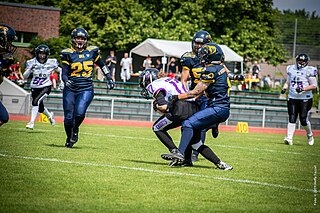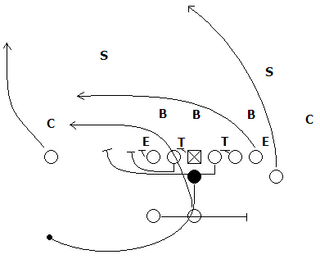Related Research Articles

Canadian football, or simply football, is a sport in Canada in which two teams of 12 players each compete on a field 110 yards (101 m) long and 65 yards (59 m) wide, attempting to advance a pointed oval-shaped ball into the opposing team's end zone.
In gridiron football, not all players on offense are entitled to receive a forward pass: only an eligible pass receiver may legally catch a forward pass, and only an eligible receiver may advance beyond the neutral zone if a forward pass crosses into the neutral zone. If the pass is received by a non-eligible receiver, it is "illegal touching". If an ineligible receiver is beyond the neutral zone when a forward pass crossing the neutral zone is thrown, a foul of "ineligible receiver downfield" is called. Each league has slightly different rules regarding who is considered an eligible receiver.

The quarterback, colloquially known as the "signal caller", is a position in gridiron football. Quarterbacks are members of the offensive platoon and mostly line up directly behind the offensive line. In modern American football, the quarterback is usually considered the leader of the offense, and is often responsible for calling the play in the huddle. The quarterback also touches the ball on almost every offensive play, and is almost always the offensive player that throws forward passes. When the QB is tackled behind the line of scrimmage, it is called a sack.

In gridiron football, a lineman is a player who specializes in play at the line of scrimmage. The linemen of the team currently in possession of the ball are the offensive line, while linemen on the opposing team are the defensive line. A number of NFL rules specifically address restrictions and requirements for the offensive line, whose job is to help protect the quarterback from getting sacked for a loss, or worse, fumbling. The defensive line is covered by the same rules that apply to all defensive players. Linemen are usually the largest players on the field in both height and weight, since their positions usually require less running and more strength than skill positions.

A cornerback (CB) is a member of the defensive backfield or secondary in gridiron football. Cornerbacks cover receivers most of the time, but also blitz and defend against such offensive running plays as sweeps and reverses. They create turnovers through hard tackles, interceptions, and deflecting forward passes.

In gridiron football, a sack occurs when the quarterback is tackled behind the line of scrimmage before throwing a forward pass, when the quarterback is tackled behind the line of scrimmage in the "pocket" and without clear intent, or when a passer runs out of bounds behind the line of scrimmage due to defensive pressure. This often occurs if the opposing team's defensive line, linebackers or defensive backs are able to apply pass pressure to quickly get past blocking players of the offensive team, or if the quarterback is unable to find a back to hand the ball off to or an available eligible receiver to catch the ball, allowing the defense a longer opportunity to tackle the quarterback.

American and Canadian football are gridiron codes of football that are very similar; both have their origins partly in rugby football, but some key differences exist between the two codes.
In American and Canadian football, pass interference (PI) is a foul that occurs when a player interferes with an eligible receiver's ability to make a fair attempt to catch a forward pass. Pass interference may include tripping, pushing, pulling, or cutting in front of the receiver, covering the receiver's face, or pulling on the receiver's hands or arms. It does not include catching or batting the ball before it reaches the receiver. Once the ball touches any defensive player or eligible offensive receiver, the above rules no longer apply and the defender may tackle the receiver or attempt to prevent them from gaining control of the ball. Once a forward pass is in the air it is a loose ball and thus any eligible receiver – all defensive players are eligible receivers – may try to catch it. When a defensive player catches a forward pass it is an interception and their team gains possession of the ball. Some actions that are defined as pass interference may be overlooked if the defender is attempting to catch or bat the ball rather than focusing on the receiver.
Strategy is a major part of American football.

Gameplay in American football consists of a series of downs, individual plays of short duration, outside of which the ball is or is not in play. These can be plays from scrimmage – passes, runs, punts or field goal attempts – or free kicks such as kickoffs and fair catch kicks. Substitutions can be made between downs, which allows for a great deal of specialization as coaches choose the players best suited for each particular situation. During a play, each team should have no more than 11 players on the field, and each of them has specific tasks assigned for that specific play.
In gridiron football, clock management is an aspect of game strategy that focuses on the game clock and/or play clock to achieve a desired result, typically near the end of a match. Depending on the game situation, clock management may entail playing in a manner that either slows or quickens the time elapsed from the game clock, to either extend the match or hasten its end. When the desired outcome is to end the match quicker, it is analogous to "running out the clock" seen in many sports. Clock management strategies are a significant part of American football, where an elaborate set of rules dictates when the game clock stops between downs, and when it continues to run.

In American football, a bootleg play is a play in which the quarterback runs with the ball in the direction of either sideline behind the line of scrimmage. This can be accompanied by a play action, or fake hand off of the ball to a running back running the opposite direction.
An incomplete pass is a term in gridiron football which means that a legal forward pass is not successfully caught by an eligible offensive player within the field of play. An incomplete pass can occur if (1) the ball hits the ground in the field of play before a player on either team gains possession; (2) the ball is caught by a player on either team who, at the moment of possession is out of bounds; or (3) the ball is thrown outside the field of play. An incomplete pass causes the down to advance by one and the offensive team gains no yards. The game clock is stopped.
A formation in American football refers to the position players line up in before the start of a down. There are both offensive and defensive formations and there are many formations in both categories. Sometimes, formations are referred to as packages.
A trick play, also known as a gadget play, gimmick play or trickeration, is a play in gridiron football that uses deception and unorthodox tactics to fool the opposing team. A trick play is often risky, offering the potential for a large gain or a touchdown if it is successful, but with the chance of a significant loss of yards or a turnover if not. Trick plays are rarely used not only because of the riskiness, but also to maintain the element of surprise for when they are used.
The offensive backfield is an ambiguous generic term of football, which includes: (1) a place, namely the area of an American football field behind the line of scrimmage; and (2) a group classification of certain players positioned there, i.e., members of offense who begin plays behind the line, typically including any backs on the field, such as the quarterback, halfbacks and fullback. There are rules specific to the manner of play in that area.
Total offense is a gridiron football statistic representing the total number of yards rushing and yards passing by a team or player. Total offense differs from yards from scrimmage, which gives credit for passing yardage to the person receiving the football rather than the person throwing the football.
The following terms are used in American football, both conventional and indoor. Some of these terms are also in use in Canadian football; for a list of terms unique to that code, see Glossary of Canadian football.

In gridiron football, a penalty is a sanction assessed against a team for a violation of the rules, called a foul. Officials initially signal penalties by tossing a bright yellow colored penalty flag onto the field toward or at the spot of a foul.
References
- 1 2 Official Rules of the NFL, Rule 8-3-1.
- ↑ Berry, Elmer (1921). The Forward Pass in Football.
- ↑ Don Pierson (1993-07-23). "More Protection Awaits Qb Assets". Chicago Tribune.
- ↑ "Revised Intentional Grounding, Chop Block Rules Headline 2022 High School Football Rules Changes" (Press release). National Federation of State High School Associations. February 17, 2022. Retrieved February 25, 2023.
- ↑ Beacom, Mike (3 August 2010). The Complete Idiot's Guide to Understanding Football. ISBN 9781101458785.
- ↑ Theismann, Joe; Tarcy, Brian (July 2001). The complete idiot's guide to football. ISBN 9781101221976.
- ↑ Jackson, Scoop (January 26, 2012). "The Pro Bowl's search for meaning". ESPN.com. Retrieved 25 January 2012.